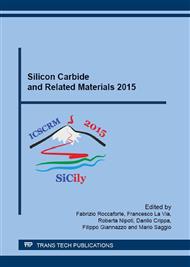[1]
Silicon Carbide (SiC) Microelectromechanical Systems (MEMS) for Harsh Environments, edited by R. Cheung, Imperial College Press, (2006).
DOI: 10.1142/9781860949098_0001
Google Scholar
[2]
M. Mehregany and C.A. Zorman, Thin Solid Films 355-356 (1999) 518.
Google Scholar
[3]
P.M. Sarro, Sensors and Actuators 82 (2000) 210.
Google Scholar
[4]
S. Nishino, J.A. Powell, H.A. Will, Applied Physics Letters 42 (1983) 460.
Google Scholar
[5]
J. Eriksson, M.H. Weng, F. Roccaforte, F. Giannazzo, S. Leone, V. Raineri. Applied Physics Letters 95 (2009) 081907.
DOI: 10.1063/1.3211965
Google Scholar
[6]
X. Song, J. F. Michaud, F. Cayrel, M. Zielinski, M. Portail, T. Chassagne, E. Collard and D. Alquier, Applied Physics Letters 96 (2010) 142104.
DOI: 10.1063/1.3383233
Google Scholar
[7]
Stephen E. Saddow, Silicon Carbide Biotechnology - A Biocompatible Semiconductor for Advanced Biomedical Devices and Applications, Elsevier, (2011).
Google Scholar
[8]
W. Chang and C. Zorman. Journal of Materials Science 43 (2008) 4512.
Google Scholar
[9]
M. Placidi, P. Godignon, N. Mestres, G. Abadal, G. Ferro, A. Leycuras and T. Chassagne. Sensors and Actuators B 133 (2008) 276.
DOI: 10.1016/j.snb.2007.07.148
Google Scholar
[10]
R. Boubekri, E. Cambril, L. Couraud, L. Bernardi, A. Madouri, M. Portail, T. Chassagne, C. Moisson, M. Zielinski, S. Jiao, J. -F. Michaud, D. Alquier, J. Bouloc, L. Nony, F. Bocquet, C. Loppacher, D. Martrou and S. Gauthier. Journal of Applied Physics 116 (2014).
DOI: 10.1063/1.4891833
Google Scholar
[11]
M.B.J. Wijesundara and R. Azevedo. Silicon carbide microsystems for harsh environments. MEMS Reference Shelf 22. Springer (2011).
DOI: 10.1007/978-1-4419-7121-0
Google Scholar
[12]
S. Sundararajan and B. Bhushan. Wear 217 (1998) 251.
Google Scholar
[13]
B. Pecholt and P. Molian. Materials and Design 32 (2011) 3414.
Google Scholar
[14]
C. Locke, G. Kravchenko, P. Waters, J.D. Reddy, K. Du, A.A. Volinsky, C.L. Frewin and S.E. Saddow, Materials Science Forum 615–617 (2009) 633.
DOI: 10.4028/www.scientific.net/msf.615-617.633
Google Scholar
[15]
S. Jiao, J.F. Michaud, M. Portail, A. Madouri, T. Chassagne, M. Zielinski and D. Alquier, Materials Letters 77 (2012) 54.
DOI: 10.1016/j.matlet.2012.02.128
Google Scholar
[16]
C. Cardinaud, M.C. Peignon, P.Y. Tessier. Applied Surface Science 164 (2000) 72.
Google Scholar
[17]
P.H. Yih, V. Saxena and A.J. Steckl. Physica Status Solidi (b) 202 (1997) 605.
Google Scholar
[18]
3C-SiC: from electronic to MEMS devices, in Advanced Silicon Carbide Devices and Processing, edited by S.E. Saddow and F. La Via, Intech, 2015 ISBN 978-953-51-2168-8.
DOI: 10.5772/61020
Google Scholar
[19]
J.F. Michaud, S. Jiao, A.E. Bazin, M. Portail, T. Chassagne, M. Zielinski and D. Alquier, Materials Research Society Symposium Proceedings 1246 (2010) B09-04.
DOI: 10.1557/proc-1246-b09-04
Google Scholar
[20]
R. Anzalone, M. Camarda, A. Canino, N. Piluso, F. La Via, and G. D'Arrigo, Electrochem. Solid-State Lett. 2011 14(4): H161-H162.
DOI: 10.1149/1.3544492
Google Scholar
[21]
K. Yagi and H. Nagasawa, Materials Science Forum 264-268 (1998) 191.
Google Scholar
[22]
T. Tong, M. Mehregany and L.G. Matus, Applied Physics Letters 60, 2992 (1992).
Google Scholar
[23]
W. Fang and J. A. Wickert, Journal of Micromechanics and Microengineering 6 (1996) 301.
Google Scholar
[24]
M. Zielinski, J.F. Michaud, S. Jiao, T. Chassagne, A.E. Bazin, A. Michon, M. Portail and D. Alquier, Journal of Applied Physics 111 (2012) 53507.
DOI: 10.1063/1.3687370
Google Scholar
[25]
J.F. Michaud, M. Portail, T. Chassagne, M. Zielinski and D. Alquier, Microelectronic Engineering 105 (2013) 65.
DOI: 10.1016/j.mee.2013.01.010
Google Scholar
[26]
R. Khazaka, M. Portail, P. Vennéguès, D. Alquier and J.F. Michaud, Acta Materialia 98 (2015) 336.
DOI: 10.1016/j.actamat.2015.07.052
Google Scholar
[27]
R. Khazaka, M. Portail, P. Vennéguès, M. Zielinski, T. Chassagne, D. Alquier, J.F. Michaud, Materials Science Forum 821 (2015) 978-981.
DOI: 10.4028/www.scientific.net/msf.821-823.978
Google Scholar
[28]
R. Khazaka, E. Bahette, M. Portail, D. Alquier and J.F. Michaud, Materials Letters 160 (2015) 28.
DOI: 10.1016/j.matlet.2015.07.071
Google Scholar


